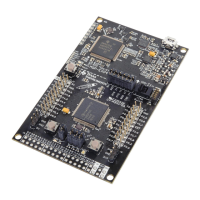www.ti.com
External Power
25
SLAU278Y–May 2009–Revised March 2016
Submit Documentation Feedback
Copyright © 2009–2016, Texas Instruments Incorporated
Design Considerations for In-Circuit Programming
2.2 External Power
The MSP-FET430UIF can supply targets with up to 60 mA through pin 2 of the 14-pin connector. Note
that the target should not consume more than 60 mA, even as a peak current, as it may violate the USB
specification. For example, if the target board has a capacitor on V
CC
more than 10 µF, it may cause
inrush current during capacitor charging that may exceed 60 mA. In this case, the current should be
limited by the design of the target board, or an external power supply should be used.
The V
CC
for the target can be selected between 1.8 V and 3.6 V in steps of 0.1 V. Alternatively, the target
can be supplied externally. In this case, the external voltage should be connected to pin 4 of the 14-pin
connector. The MSP-FET430UIF then adjusts the level of the JTAG signals to external V
CC
automatically.
Only pin 2 (MSP-FET430UIF supplies target) or pin 4 (target is externally supplied) must be connected;
not both at the same time.
When a target socket module is powered from an external supply, the external supply powers the device
on the target socket module and any user circuitry connected to the target socket module, and the FET
interface module continues to be powered from the PC through the parallel port. If the externally supplied
voltage differs from that of the FET interface module, the target socket module must be modified so that
the externally supplied voltage is routed to the FET interface module (so that it may adjust its output
voltage levels accordingly). See the target socket module schematics in Appendix B.
The PC parallel port can source a limited amount of current. Because of the ultra-low-power requirement
of the MSP430, a stand-alone FET does not exceed the available current. However, if additional circuitry
is added to the tool, this current limit could be exceeded. In this case, external power can be supplied to
the tool through connections provided on the target socket modules. See the schematics and pictorials of
the target socket modules in Appendix B to locate the external power connectors. Note that the MSP-
FET430PIF is not recommended for new design.
2.3 Bootloader (BSL)
The JTAG pins provide access to the memory of the MSP430 and CC430 devices. On some devices,
these pins are shared with the device port pins, and this sharing of pins can complicate a design (or
sharing may not be possible). As an alternative to using the JTAG pins, most MSP430Fxxx devices
contain a program (a "bootloader", formerly knows as the "bootstrap loader") that permits the flash
memory to be erased and programmed using a reduced set of signals. The MSP430 Programming With
the Bootloader (BSL) User's Guide (SLAU319) describes this interface. See the MSP430 website for the
application reports and a list of MSP430 BSL tool developers.
TI suggests that MSP430Fxxx customers design their circuits with the BSL in mind (that is, TI suggests
providing access to these signals by, for example, a header).
See FAQ Hardware #10 for a second alternative to sharing the JTAG and port pins.

